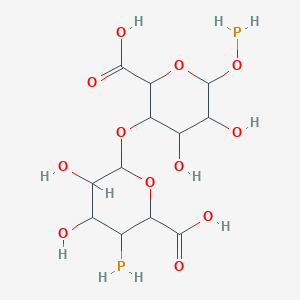



1. Alginate, Barium
2. Alginate, Calcium
3. Alginate, Copper
4. Alginate, Potassium
5. Alginate, Sodium
6. Alginate, Sodium Calcium
7. Alginates
8. Alginic Acid, Barium Salt
9. Alginic Acid, Calcium Salt
10. Alginic Acid, Copper Salt
11. Alginic Acid, Potassium Salt
12. Alginic Acid, Sodium Salt
13. Alloid G
14. Barium Alginate
15. Calcium Alginate
16. Calcium Alginate, Sodium
17. Calginat
18. Copper Alginate
19. Kalrostat
20. Kalrostat 2
21. Kaltostat
22. Poly(mannuronic Acid), Sodium Salt
23. Potassium Alginate
24. Sodium Alginate
25. Sodium Calcium Alginate
26. Vocoloid
27. Xantalgin
1. Kelacid
2. Sazio
3. Gum Levan
4. Levan Gum
5. E400
| Molecular Weight | 418.23 g/mol |
|---|---|
| Molecular Formula | C12H20O12P2 |
| XLogP3 | -4 |
| Hydrogen Bond Donor Count | 6 |
| Hydrogen Bond Acceptor Count | 12 |
| Rotatable Bond Count | 5 |
| Exact Mass | 418.04300006 g/mol |
| Monoisotopic Mass | 418.04300006 g/mol |
| Topological Polar Surface Area | 192 Ų |
| Heavy Atom Count | 26 |
| Formal Charge | 0 |
| Complexity | 534 |
| Isotope Atom Count | 0 |
| Defined Atom Stereocenter Count | 0 |
| Undefined Atom Stereocenter Count | 10 |
| Defined Bond Stereocenter Count | 0 |
| Undefined Bond Stereocenter Count | 0 |
| Covalently Bonded Unit Count | 1 |
Indicated for the management of gastric reflux, reflux oesophagitis, hiatus hernia, heartburn (including heartburn of pregnancy) and similar gastric distress.
Alginic acid reduces reflux via its floating, foaming, and viscous properties. Alginic acid precipitates upon contact with gastric acid to create a mechanical barrier, or a "raft", that displaces the postprandial acid pocket. The formation of a raft is thought to occur rapidly, often within a few seconds of dosing. In clinical trials, alginic acid was effective in reducing the symptoms of gastroesophageal reflux disease (GERD). In healthy volunteers, alginic acid in combination with an antacid was effective in decreasing postprandial reflux in the upright position. Alginic acid is able to bind to cations when ingested.
Absorption
The absorption into the systemic circulation from oral formulations of alginic acid is reported to be minimal, as the mode of action of alginic acid is physical.
Route of Elimination
This pharmacokinetic parameter is unlikely to apply for alginic acid.
Volume of Distribution
This pharmacokinetic parameter is unlikely to apply for alginic acid.
Clearance
This pharmacokinetic parameter is unlikely to apply for alginic acid.
This pharmacokinetic parameter is unlikely to apply for alginic acid.
This pharmacokinetic parameter is unlikely to apply for alginic acid.
Once orally administered, alginic acid reacts with gastric acid to form a floating "raft" of alginic acid gel on the gastric acid pool. Alginate-based raft-forming formulations commonly contain sodium or bicarbonate; bicarbonate ions are converted to carbon dioxide in presence of gastric acid and get entrapped within the gel precipitate, converting it into a foam which floats on the surface of the gastric contents, much like a raft on water. The "raft" has a near neutral pH due to carbon dioxide and floats on the stomach contents and potentially functions as a barrier to impede gastroesophageal reflux. In severe cases, the raft itself may be refluxed into the oesophagus in preference to the stomach contents and exert a demulcent effect.